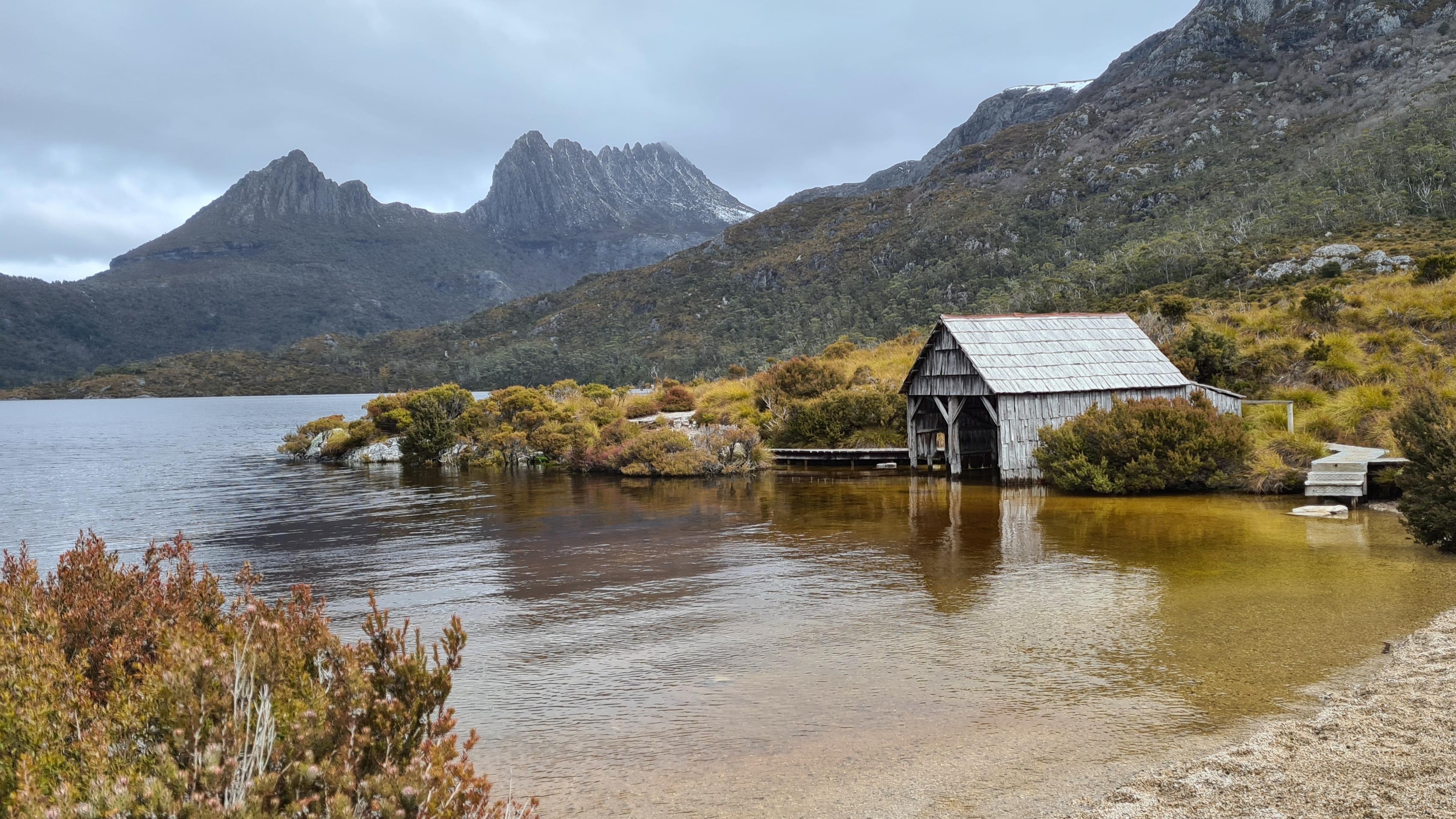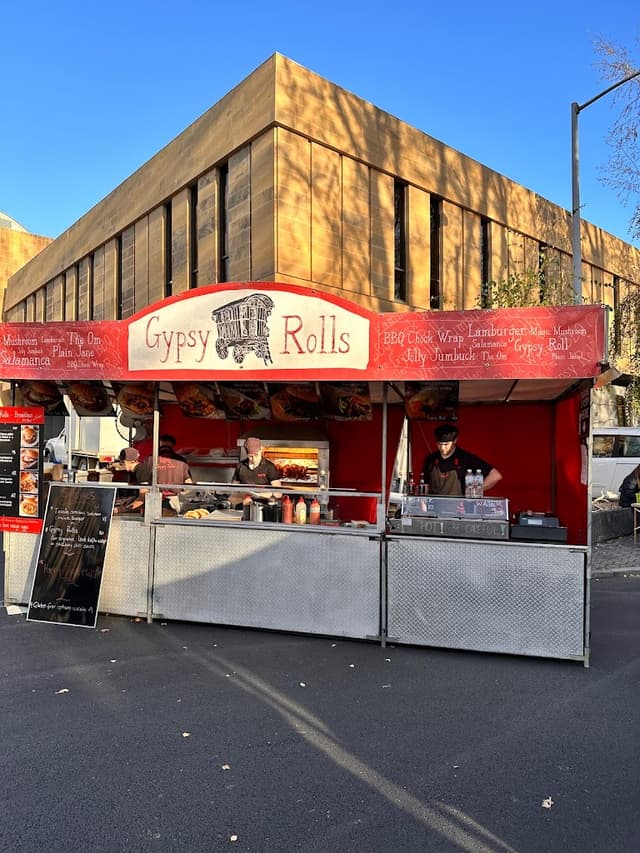Fast facts:
- Home to the Tasmanian Devil - the world's largest carnivorous marsupial
- Over 50% of the state is protected area - preserving a rich cultural heritage and outstanding natural attractions
- Has the largest lavender farm in the Southern Hemisphere, Bridestowe Lavendar Estate
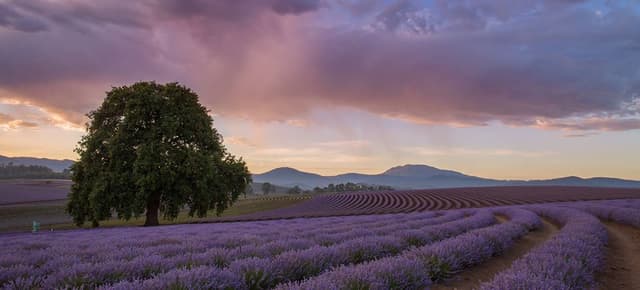
Bridestowe Lavender Estate
@ecoconscioustravel
Open daily from 10am to 4pm (including public holidays).
Bridestowe Lavender Estate is one of Tasmania's most popular tourist destinations, around a 50-minute drive from Launceston. Bridestowe is the largest lavender farm in the Southern Hemisphere, famous for the spectacular view of the lavender in bloom in December and January.
Visitors are welcome all year round to see the seasons of Tasmania beautifully reflected in the ornamental gardens, manicured fields and native bushland set against the striking backdrop of Mount Arthur.
The visitor centre is stocked with unique products containing Bridestowe's famous lavender oil and dried flower. Also, an extensive range of fragrant Australian-made gifts created for the bath, body and home and the world-famous Bobbie the Bear.
The Woodcroft Cafe offers a delicious range of lavender inspired delicacies including a signature range of lavender ice-creams and light seasonal meals.
An entry fee of AU$20 per adult applies during the "Festival of Flowers" - 1 December to 31 January. Under 16s are free of charge. Entry to the Estate is free from February to November.

Details
Things to do:
1. Have a blast at Cradle Mountain-Lake St Clair National Park
This awesome national park is where you can find the Overland Track, a 65-kilometre adventure that takes you through snowy mountains, lush rainforests, and sparkling lakes. You can also meet some cute critters like wombats, wallabies, and Tasmanian devils, and snap some amazing photos of Cradle Mountain and Lake St Clair.
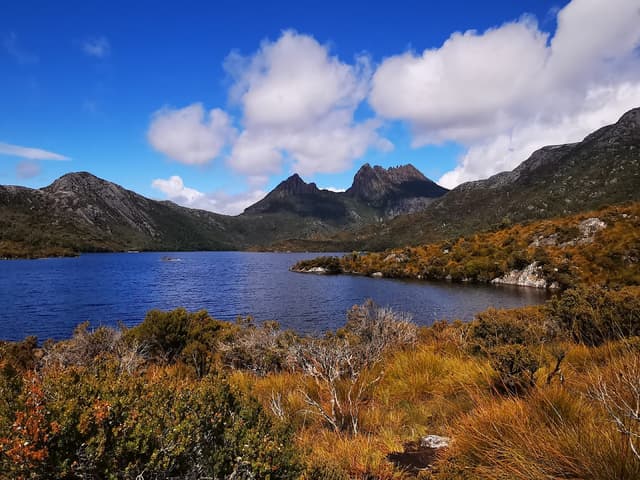
Cradle Mountain-Lake St Clair National Park
@ecoconscioustravel
Open 24/7, however shuttle buses from the Cradle Mountain visitor centre to Dove Lake and other attractions run seasonally and are subject to change:
Summer (1 October - 31 March) 8am to 6pm every 10 to 15 minutes.
Winter (1 April – 30 September) 9am to 5pm every 15 to 20 minutes.
A national parks pass is required.
Cradle Mountain-Lake St Clair National Park is part of the spectacular Tasmanian Wilderness World Heritage Area, around 1 hour 15 minutes' drive from Limilinaturi/Devonport. Wulinantikala/Cradle Mountain was ranked number 32 in Lonely Planet’s World Ultimate Travel List in 2015, ahead of Uluru, Kakadu and the Sydney Opera House.
Cradle Mountain is an absolute favourite destination of ours for hiking, camping and wildlife spotting. You are almost guaranteed to see our favourites - wombats! - and quite possibly have your food stolen by cheeky currawongs (birds) if you're not careful! Please observe all wildlife from a distance and do not feed them.
In the area, you can also visit a Tasmanian Devil wildlife sanctuary, see award-winning art galleries, or spend a snowy winter’s day sipping cognac by a fireplace in a cosy lodge as you gaze at the winter wonderland outside.
There is accommodation for all budgets, from camping and backpackers to luxury self-contained accommodation.
Cradle Mountain is a must-see for visitors to Lutruwita/Tasmania. Reach out to us at info@ecoconscioustravel.com.au if you need any tips on the best hikes in the area!

Details

Overland Track
@ecoconscioustravel
Bookings or registrations required all year round.
The iconic Overland Track is Australia's premier alpine trek. This exhilarating and life-changing journey attracts walkers from across the globe. Beginning at the iconic Cradle Mountain and ending at Australia’s deepest lake – Lake St Clair, this 65km, six-day trek takes you through the heart of the Cradle Mountain-Lake St Clair National Park, part of the magnificent Tasmanian Wilderness World Heritage Area.
Your journey will be physically demanding, emotionally challenging and scenically spectacular. This is a landscape of glacially carved valleys, ancient rainforests, fragrant eucalypt forests, golden buttongrass moorlands and beautiful alpine meadows. Optional side-trips take you to cascading waterfalls and mountain summits, including Tasmania’s highest peak, Mount Ossa (1617m).
The Overland Track is about you and your time in the wilderness, so while six days is the average time taken to walk the track, you can create your own pace depending on how many rest days or side-trips you wish to enjoy.
WARNING: The Overland Track is a serious undertaking, for well-prepared walkers, with a good level of fitness and who understand the risks of walking in a remote alpine area.
Overland Track Pass Fees apply from 1 October - 31 May inclusive:
Adults - AU$285
Children (17 years and under) - AU$245
Concession - AU$245
Walker numbers are capped each day, so bookings often sell out for the season ahead very quickly. For this reason, we haven't been able to tick off 'The OT' yet. Another option is to take a commercial tour - and we've added a link to options there for you.
If you're not sure if the Overland Track is for you but still want a great hiking experience in Australia - reach out to us as info@ecoconscioustravel.com.au for our top suggestions!

Details
2. Get your culture fix in Hobart
Hobart is the big boss of Tasmania, and a hotspot for art, history, and food. You can check out the Tasmanian Museum & Art Gallery (TMAG), which has cool stuff from the state’s past and present, or the Museum of Old and New Art (Mona), which has some crazy and edgy artworks. You can also wander around the old-school Battery Point neighbourhood or munch on some yummy seafood at the Salamanca Market.

Tasmanian Museum and Art Gallery
@ecoconscioustravel
Opening hours:
26 December - 31 March: Open daily 10am–4pm.
1 April - 24 December: Open Tuesdays to Sundays 10am-4pm.
Monday public holidays: Open 10am-4pm year-round.
Good Friday, ANZAC Day (25 April) and Christmas Day public holidays: Closed
General admission to TMAG is free. Special exhibits may occasionally require paid entry.
Prepare to spend a chunk of time here. TMAG is fascinating inside and out.
Indoors more than a million objects ranging from a prehistoric woolly mammoth tusk to contemporary works by living Tasmanian artists are carefully curated to form part of a distinctively Tasmanian story.
TMAG spokesperson Melissa Edwards says: "While visitors can learn about Tasmania’s history and heritage, they can also explore the state’s links with Antarctica, admire significant colonial artworks and get to know remarkable animals, including the thylacine - the now extinct Tasmanian tiger. Importantly, those visiting TMAG can also deepen their understanding and discover complex histories, including those of Tasmania’s First Peoples".
Easily accessible from the Nipaluna/Hobart CBD or city centre - TMAG should definitely be on your list to see. We love the textures of the sandstone buildings, including Tasmania's oldest surviving building, the early 1800s Commissariat Store, where you can stand and try to imagine the lives and cultures that clashed when Tasmania was colonised. TMAG gives you a great sense of human history in this part of the world. Highly recommended.

Details
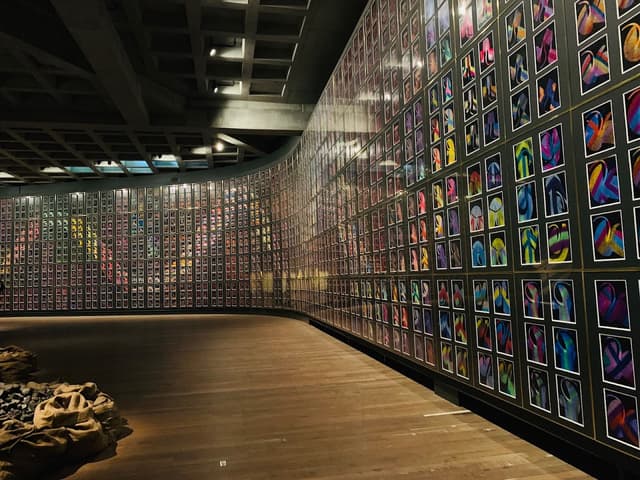
MONA
@ecoconscioustravel
Mona is open 4 days a week, Fridays to Mondays, 10am–5pm. Tasmanians can visit Mona for free, but must still book. For everyone else, museum entry is via online booking and AU$38 for adults, AU$32 concession, AU$15 for under 18s and free for under 12s. NB: Mona is cashless, including all tickets, restaurants and bars.
Mona is located 11kms north of Nipaluna/Hobart -approximately 25 minutes by Mona ferry, or 20 minutes by road. We love the Mona ferry - especially hanging out in the Posh Pit which costs a little bit extra and offers "complimentary bevvies, tiny food and inflated egos".
"Mona: a museum, or something. In Tasmania, or somewhere. Catch the ferry. Drink beer. Eat cheese. Talk crap about art. You'll love it." We couldn't have said it better!
The Museum of Old and New Art (Mona) is the brain-child of local Tasmanian, David Walsh. It is a world-renowned art collection with dining and entertainment thrown in! Some of the art is spicy, controversial, shocking - so be prepared and checkout the website to see if it's for you.
Mona isn't a stuffy old museum - and the modern buildings themselves are amazing. It's a place to "have fun, get tipsy, be shocked, be delighted, laugh, catch a gig, eat hot chippies, dine in style, hallucinate in bright lights". We love catching a gig on the outdoor stage with a beer and a snack - there's so much to fill your day at Mona with.
Onya David!

Details
Salamanca Market
@ecoconscioustravel
Salamanca Market operates on a Saturday morning from 8:30am to 3pm and is one of Australia's best and biggest artisan markets - a must-see when you visit Nipaluna/Hobart! Salamanca Market is held in Salamanca Place and is around a 10 to 15 minute walk from the CBD or city centre.
Simon is a very biased Tasmanian but he reckons Salamanca is the best market in Oz. Whether it's a tasty treat, a thoughtful gift or simply great produce - you'll find it all in abundance at Salamanca Market.
Simon's hot tip: The buskers! You'll see some amazing local musical talent. Oh and the Smallest Pancakes in Town are pretty delish too!!

Details
3. Travel back in time at the Port Arthur Historic Site
Port Arthur is an old jail and a UNESCO World Heritage Site, where you can learn about the tough life of the prisoners who were sent here between 1830 and 1877. You can explore the ruins of the prison buildings, the church, the hospital, and the cemetery, or join a tour to deepen your understanding of convict life.

Port Arthur Historic Site
@ecoconscioustravel
The Port Arthur Historic Site is open every day from 9am until 5pm (closed Christmas Day).
2-day site entry tickets from 1 July 2024 are Adult AU$48, Child AU$23 and Concession AU$38.
Port Arthur is a 90-minute drive from Nipaluna/Hobart, and the journey offers some of the best sightseeing in Lutruwita/Tasmania. The Arthur Highway winds through lush farmland and forest, inviting beaches and Turrakana/Tasman Peninsula’s famously scenic coastline. We recommend you allow enough time to stop along the way and explore places like the Tesselated Pavement at Eaglehawk Neck, and dramatic geological features such as the Blowhole, Tasman Arch and Devil’s Kitchen.
Port Arthur is Australia's most intact and evocative convict site. There is a lot to see and do with more than 30 historic buildings and ruins to explore over 100 acres so you’ll want to allow a minimum of 3 to 4 hours.
Your site entry ticket is valid for two consecutive days and includes a self-guided audio experience, complimentary site talks by expert guides at key locations throughout the day, a harbour cruise, access to the Port Arthur Gallery, house museums, and the gardens. Additional tours include the small group Commandant's tour, the Isle of the Dead Cemetery Tour, or hear of the many escape attempts with the Escape from Port Arthur tour.
The Port Arthur cafe is open daily from 9am to 5pm in the Visitor Centre.
Our top tip: There's a reason why your Port Arthur entry ticket is a 2-day ticket - there's a lot to see and do at Port Arthur! So we recommend considering at least an overnight stay, or plan for a long day trip to Turrakana/Tasman Peninsula and Port Arthur. This part of the world is one of our favourites - and we've hiked extensively on the Peninsula. So reach out to us at info@ecoconscioustravel.com.au for any further tips or suggestions!

Details
4. Hit the beach at Freycinet National Park
Freycinet National Park is a slice of heaven, with white sandy beaches, blue-green waters, and rocky peaks. You can hike to the famous Wineglass Bay lookout, which has a jaw-dropping view of the curved beach and the ocean. You can also kayak, snorkel, or swim in the clear water, or spot dolphins, whales, and seabirds along the coast.
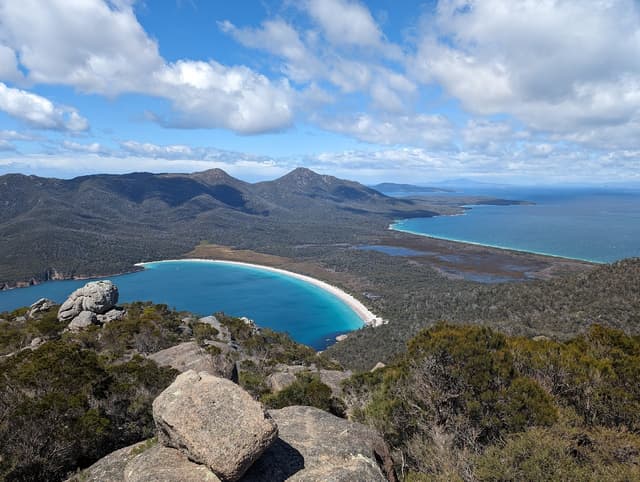
Freycinet National Park
@ecoconscioustravel
Open 24/7 but a national parks pass is required and camping fees may apply. Freycinet National Park is about 2.5 hours' drive north from Nipaluna/Hobart and south from Launceston.
This is still Simon's favourite place in the world! He loves the majestic granite peaks of The Hazards, and it's still a magic moment every time they come into view driving towards Freycinet. The campsite at the end of Wineglass Bay Beach is also one of our absolute favourites. But you don't have to rough it in a tent to visit Freycinet - there's budget to luxe accommodation options to suit everyone.
Freycinet is a global drawcard - it is iconic, memorable and breathtaking. The park is best known for the stunning beauty of Wineglass Bay - its crystal-clear waters and curvaceous white beach is one of Tasmania’s most celebrated views.
Beyond Wineglass Bay, there’s plenty more to uncover at Freycinet. The diversity in the coastal landscape is dramatic, with rocky coves and surging surf around one corner, and sheltered bays and sandy beaches around the next.
Although one of Tasmania’s most popular national parks, it is still possible to find solitude in the variety of experiences that await you at Freycinet.
You shouldn't need any more convincing from us to visit Freycinet! But if you have any questions or want some more tips - please reach out to us at info@ecoconscioustravel.com.au.

Details

Wineglass Bay Lookout
@ecoconscioustravel
Open 24/7 but a national parks pass is required.
If you've seen photos of Wineglass Bay you probably don't need any convincing from us to make it a must-see when you visit Lutruwita/Tasmania!
And you won't be alone - Wineglass Bay is rated as one of the Top 10 beaches in the world! Wineglass Bay is the most photographed view in our island state. It is about 2.5 hours' drive north from Nipaluna/Hobart and south from Launceston.
But... you'll need to allow around 1 to 1.5 hours to hike up to the lookout, climbing about 300 steps up and then of course 300 down! It is a beautiful, well-constructed trail and well worth the effort. From the lookout, it's a further 500 steps to get down to Wineglass Beach - allow 2.5 to 3.5 hours for the complete return trip. You can also return via a flatter route across the Isthmus Track in a similar timeframe.
The steps on the Lookout Track can be hard on dodgy knees - so do plan ahead and look after yourself and your group.
You should absolutely dip your toes into the crystal-clear waters of Wineglass Bay, but be aware the beach can drop off sharply under the waves. More gentle swimming locations are available at Honeymoon Bay, Richardsons Beach or Muirs Beach, depending on the prevailing weather.
As always, if we can help you with any further tips or suggestions on your visit to Freycinet, please reach out to us at info@ecoconscioustravel.com.au.

Details
5. See the sights from Kunanyi/Mount Wellington
Kunanyi/Mount Wellington is a 1,271-meter-high mountain that towers over Nipaluna/Hobart and offers stunning views of the city and the area around it. You can drive to the top which has a lookout platform and an observation shelter, or hike or bike along one of the many trails that zigzag across the mountain. You can also enjoy the different plants and animals that live at different heights of the mountain.
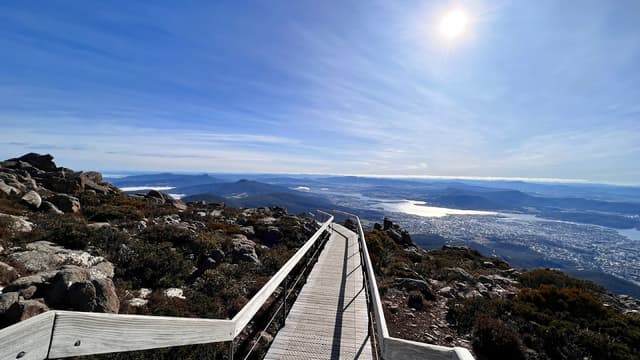
Mount Wellington
@ecoconscioustravel
Open 24/7, but Pinnacle Road to the summit may be closed due to snow and the weather conditions during winter.
The summit of Kunanyi/Mount Wellington is a 30-minute drive from the Nipaluna/Hobart CBD or city centre. A Kunanyi/Mount Wellington Explorer Bus also runs between the city and the summit.
For Hobartians, "the mountain" is part of their daily life: a barometer, a place to walk, ride mountain bikes, play in the winter snow, and to feel the reviving touch of nature.
It’s fair to say the city is dominated by Kunanyi/Mount Wellington – stand almost anywhere in Nipaluna/Hobart and you’ll see its forested flanks and the summit (weather permitting!).
Visit the summit for wonderful views of Nipaluna/Hobart and you can also see much of southern Tasmania. Head to the summit’s west side for views deep into the Southwest wilderness. Boardwalks and lookout platforms offer vantage points, along with the pinnacle observation shelter, which is open 7am-10pm from September to April, and 7am-5.30pm from May to August. There is no other shelter on the summit - so do be prepared for all weather conditions. As a rule-of-thumb, it can be around 10°C colder on the summit than in the city, and temperatures can hover around freezing in the cooler months.
We love exploring the trails in Wellington Park, so don't hesitate to reach out if we can give you any tips for your visit to Kunanyi/Mount Wellington.

Details
* * *
